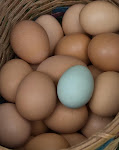Last weekend I took down my bamboo tepees with what was left of my summer tomato plants after having been ravaged by tomato hornworms (see earlier post with pic of Gozer, the destructor) and stinkbugs. I couldn't do any spraying because of the ducks and bantams in the garden.
In discussing our tomato plants, Jeff Moore (who bought his plants at the trade school nursery, too) and I decided that the variety of large tomato plants we bought didn't produce as much as we wanted and expected them to. The grape tomatoes did fine, but the others were smallish and none too plentiful. I think they were called "Amelia". The heirlooms I planted in August have made nice plants, but aren't fruiting as much as I expected. I need to fertilize.
I harvested tons of basil of different varieties and trimmed my rosemary plants saving those sticky, delicious-smelling cuttings, too. The basil plants are rebounding nicely from such a harsh cutting because of the rain, and the okra has gone NUTS with the tall tomato structures (which had been shading them) gone.
The rattlesnake beans I planted in August are producing like crazy! I'm getting a half pound to a pound a day! This is DEFINITELY the variety to plant! They grow from seed quickly, produce VOLUMES, and the purple striping on the beans make them easy to see and pick. Also, they don't have that "fuzz" on them, so they are easy to wash. Delicious and hearty, they'll be great for canning, too. I had planted more yardlong green beans, and they are coming along, too. They are even more delicious, but too delicate for canning. GREAT for stir frying. I've planted more of each for a great fall harvest (if the frost holds off.)
I've planted tons more purple hull cowpeas, too. I just LOVE these peas. I have put up quart after quart of them. I love the way they grow, but I just hadn't planted enough for our crew until now.
I planted some "superset" squash, too. I planted much earlier, but the ducks enjoyed eating the small plants and they were gone. Hubby bought broccoli and brussels sprouts plants - a whole flat each! We planted them beside the purple hull peas. I also planted beets, radishes, spinach, swiss chard, leeks, and carrots from seed. I'm so excited to see how this will do as time goes by.
I am going to spray now that the ducks and bantams are out of the garden, and add fertilizer to hedge my bets. I know some of these plantings don't match the "you should plant now" dates, but obviously, the rattlesnake beans don't know any better than to just grow and produce any way. I hope the other stuff is that way, too.
Saturday, September 19, 2009
Tuesday, September 8, 2009
Things we've learned about farming and gardening this summer . . .
GARDENING
Next spring, summer, and fall my garden will be a money SAVER, but this past growing season, my garden was a money pit! I also had some other gardening issues that kept my garden from being as productive as possible.
HOSES: I spent over $120 on drip hoses that kept getting big holes in the first few inches and just not working like they should. They are warrantied, so I'm returning some of them to exchange for new ones (that will also leak???).
SEEDS: I have a little spending problem when it comes to seeds. I just like buying them. LOTS of them. Way more than I need of them. I also had a lack of familiarity with what varieties WORK in my own soil (in its current condition) and will not waste money on things I can't grow. (I will experiment, but not PACKETS worth.) I'm also saving seed from lots of varieties that aren't hybrids. I will have my own store of seeds for next year.
WATERING: I'm going to spend the winter months adding gobs of organic material from my compost pile and worm bins to the soil in the garden. By growing season, I hope to have amended my sandy soil with enough stuff to make it hold more moisture. Also, the well is working now and we will be using "free" water from it or from harvested rainwater.
LACK OF SUNLIGHT: This is our first full year on this property, and although I got a full 8 hours of sun (or more) during the winter months, I got 6 or less in some areas of the garden during the summer. We are going to remove 4 trees in different spots surrounding the garden, and that should increase my hours of sunlight. If not, we will take out more. The garden is priority #1.
SOIL QUALITY: I learned that the dark, rich look of soil means nothing. I think there are some spots in that garden that are as empty of nutrients as a sandbox. I'm going to PILE on the compost, mix it in, and plant a cover crop to really get that garden ready. In January, I'm going to take samples of soil and test them for PH and for nutrients and see what I need to add in time for growing season.
With all these changes, I think I'll see a much higher production in the garden next year. For all the crops that still won't grow, I know how to buy those at the cattle sale or at the U-pick farms around here at good prices.
FARMING
We learned that farming is not for the faint of heart or for the weak of body or for the low of cash. At least for now, all animals are a COST center. At some point, there may be some money made, but right now it's just a really expensive hobby.
GOATS: We're ABSOLUTELY sure we only want to raise pygmy goats. Bigger goats eat more food! Pens have to be bigger, they make more poo, take more medication, are harder to handle when you need to move them, etc. . . . .
CHICKENS: The first six plus months of having chickens is all about spending money. Build the pens, buy the feeders, buy the waterers, buy the feed, buy the medications, buy more feed, buy more feed, buy more feed. We ARE getting smarter about it, though. I have 40 some odd 12 week old pullets left from the almost 200 I had over the summer. I am letting them range freely every day after the morning feeding (of other animals) until the evening feeding. They are eating very little feed, and they are consuming tons of bugs!! Luckily, no predators have gotten after them in the daytime. When they are closer to laying age, I will have to figure out what to do about nesting boxes. Meanwhile, I'm still running an ad in the Mule Trader trying to sell them. The laying hens are completely cooped up until their laying habits are well established. Then I will let them range after laying time until evening feedings. Chickens will cost much less to feed then.
DUCKS: The jury is still out on raising ducks. Out of 7 ducks, I think 3 or 4 are male, and the others are female. I only want to keep one drake, and that will be "Spot." Then I want my ducks to lay eggs. They are so messy, and they are a hazard to starter plants in the garden, but they are supposed to be great layers, and I could raise a few more for layers if I like the eggs. They should start laying in November.
RABBITS: It takes lots of cages to "farm" rabbits for meat. (We still haven't slaughtered any.)
QUAILS: These birds are GREAT!! If all we did was sell their eggs, these birds would be worth the time, effort, and costs involved. Hatching the babies is really fun, too.
Next spring, summer, and fall my garden will be a money SAVER, but this past growing season, my garden was a money pit! I also had some other gardening issues that kept my garden from being as productive as possible.
HOSES: I spent over $120 on drip hoses that kept getting big holes in the first few inches and just not working like they should. They are warrantied, so I'm returning some of them to exchange for new ones (that will also leak???).
SEEDS: I have a little spending problem when it comes to seeds. I just like buying them. LOTS of them. Way more than I need of them. I also had a lack of familiarity with what varieties WORK in my own soil (in its current condition) and will not waste money on things I can't grow. (I will experiment, but not PACKETS worth.) I'm also saving seed from lots of varieties that aren't hybrids. I will have my own store of seeds for next year.
WATERING: I'm going to spend the winter months adding gobs of organic material from my compost pile and worm bins to the soil in the garden. By growing season, I hope to have amended my sandy soil with enough stuff to make it hold more moisture. Also, the well is working now and we will be using "free" water from it or from harvested rainwater.
LACK OF SUNLIGHT: This is our first full year on this property, and although I got a full 8 hours of sun (or more) during the winter months, I got 6 or less in some areas of the garden during the summer. We are going to remove 4 trees in different spots surrounding the garden, and that should increase my hours of sunlight. If not, we will take out more. The garden is priority #1.
SOIL QUALITY: I learned that the dark, rich look of soil means nothing. I think there are some spots in that garden that are as empty of nutrients as a sandbox. I'm going to PILE on the compost, mix it in, and plant a cover crop to really get that garden ready. In January, I'm going to take samples of soil and test them for PH and for nutrients and see what I need to add in time for growing season.
With all these changes, I think I'll see a much higher production in the garden next year. For all the crops that still won't grow, I know how to buy those at the cattle sale or at the U-pick farms around here at good prices.
FARMING
We learned that farming is not for the faint of heart or for the weak of body or for the low of cash. At least for now, all animals are a COST center. At some point, there may be some money made, but right now it's just a really expensive hobby.
GOATS: We're ABSOLUTELY sure we only want to raise pygmy goats. Bigger goats eat more food! Pens have to be bigger, they make more poo, take more medication, are harder to handle when you need to move them, etc. . . . .
CHICKENS: The first six plus months of having chickens is all about spending money. Build the pens, buy the feeders, buy the waterers, buy the feed, buy the medications, buy more feed, buy more feed, buy more feed. We ARE getting smarter about it, though. I have 40 some odd 12 week old pullets left from the almost 200 I had over the summer. I am letting them range freely every day after the morning feeding (of other animals) until the evening feeding. They are eating very little feed, and they are consuming tons of bugs!! Luckily, no predators have gotten after them in the daytime. When they are closer to laying age, I will have to figure out what to do about nesting boxes. Meanwhile, I'm still running an ad in the Mule Trader trying to sell them. The laying hens are completely cooped up until their laying habits are well established. Then I will let them range after laying time until evening feedings. Chickens will cost much less to feed then.
DUCKS: The jury is still out on raising ducks. Out of 7 ducks, I think 3 or 4 are male, and the others are female. I only want to keep one drake, and that will be "Spot." Then I want my ducks to lay eggs. They are so messy, and they are a hazard to starter plants in the garden, but they are supposed to be great layers, and I could raise a few more for layers if I like the eggs. They should start laying in November.
RABBITS: It takes lots of cages to "farm" rabbits for meat. (We still haven't slaughtered any.)
QUAILS: These birds are GREAT!! If all we did was sell their eggs, these birds would be worth the time, effort, and costs involved. Hatching the babies is really fun, too.
Subscribe to:
Posts (Atom)




